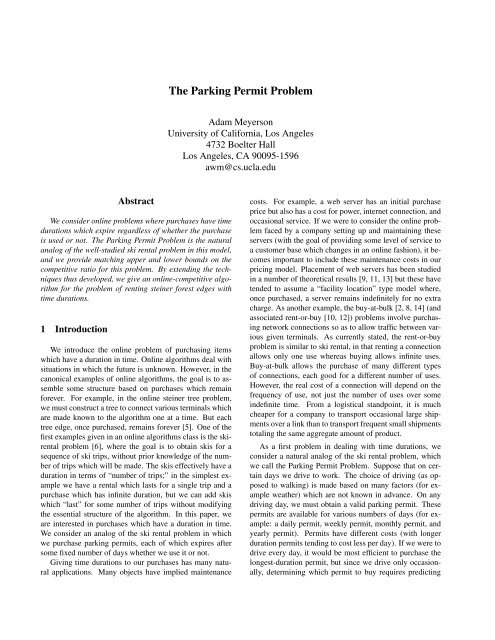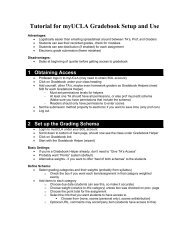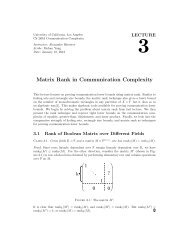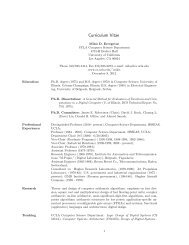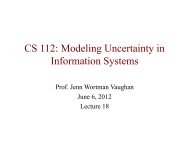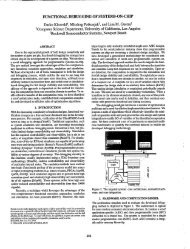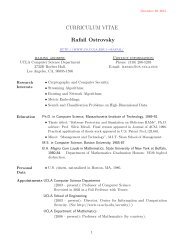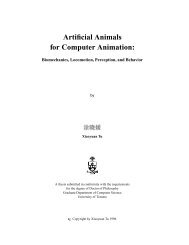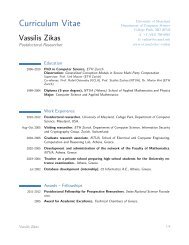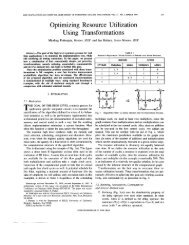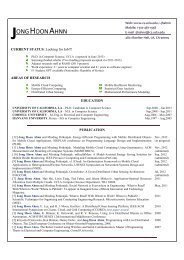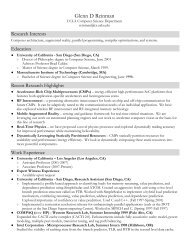The Parking Permit Problem - CiteSeerX
The Parking Permit Problem - CiteSeerX
The Parking Permit Problem - CiteSeerX
You also want an ePaper? Increase the reach of your titles
YUMPU automatically turns print PDFs into web optimized ePapers that Google loves.
Abstract<br />
We consider online problems where purchases have time<br />
durations which expire regardless of whether the purchase<br />
is used or not. <strong>The</strong> <strong>Parking</strong> <strong>Permit</strong> <strong>Problem</strong> is the natural<br />
analog of the well-studied ski rental problem in this model,<br />
and we provide matching upper and lower bounds on the<br />
competitive ratio for this problem. By extending the techniques<br />
thus developed, we give an online-competitive algorithm<br />
for the problem of renting steiner forest edges with<br />
time durations.<br />
1 Introduction<br />
We introduce the online problem of purchasing items<br />
which have a duration in time. Online algorithms deal with<br />
situations in which the future is unknown. However, in the<br />
canonical examples of online algorithms, the goal is to assemble<br />
some structure based on purchases which remain<br />
forever. For example, in the online steiner tree problem,<br />
we must construct a tree to connect various terminals which<br />
are made known to the algorithm one at a time. But each<br />
tree edge, once purchased, remains forever [5]. One of the<br />
first examples given in an online algorithms class is the skirental<br />
problem [6], where the goal is to obtain skis for a<br />
sequence of ski trips, without prior knowledge of the number<br />
of trips which will be made. <strong>The</strong> skis effectively have a<br />
duration in terms of “number of trips;” in the simplest example<br />
we have a rental which lasts for a single trip and a<br />
purchase which has infinite duration, but we can add skis<br />
which “last” for some number of trips without modifying<br />
the essential structure of the algorithm. In this paper, we<br />
are interested in purchases which have a duration in time.<br />
We consider an analog of the ski rental problem in which<br />
we purchase parking permits, each of which expires after<br />
some fixed number of days whether we use it or not.<br />
Giving time durations to our purchases has many natural<br />
applications. Many objects have implied maintenance<br />
<strong>The</strong> <strong>Parking</strong> <strong>Permit</strong> <strong>Problem</strong><br />
Adam Meyerson<br />
University of California, Los Angeles<br />
4732 Boelter Hall<br />
Los Angeles, CA 90095-1596<br />
awm@cs.ucla.edu<br />
costs. For example, a web server has an initial purchase<br />
price but also has a cost for power, internet connection, and<br />
occasional service. If we were to consider the online problem<br />
faced by a company setting up and maintaining these<br />
servers (with the goal of providing some level of service to<br />
a customer base which changes in an online fashion), it becomes<br />
important to include these maintenance costs in our<br />
pricing model. Placement of web servers has been studied<br />
in a number of theoretical results [9, 11, 13] but these have<br />
tended to assume a “facility location” type model where,<br />
once purchased, a server remains indefinitely for no extra<br />
charge. As another example, the buy-at-bulk [2, 8, 14] (and<br />
associated rent-or-buy [10, 12]) problems involve purchasing<br />
network connections so as to allow traffic between various<br />
given terminals. As currently stated, the rent-or-buy<br />
problem is similar to ski rental, in that renting a connection<br />
allows only one use whereas buying allows infinite uses.<br />
Buy-at-bulk allows the purchase of many different types<br />
of connections, each good for a different number of uses.<br />
However, the real cost of a connection will depend on the<br />
frequency of use, not just the number of uses over some<br />
indefinite time. From a logistical standpoint, it is much<br />
cheaper for a company to transport occasional large shipments<br />
over a link than to transport frequent small shipments<br />
totaling the same aggregate amount of product.<br />
As a first problem in dealing with time durations, we<br />
consider a natural analog of the ski rental problem, which<br />
we call the <strong>Parking</strong> <strong>Permit</strong> <strong>Problem</strong>. Suppose that on certain<br />
days we drive to work. <strong>The</strong> choice of driving (as opposed<br />
to walking) is made based on many factors (for example<br />
weather) which are not known in advance. On any<br />
driving day, we must obtain a valid parking permit. <strong>The</strong>se<br />
permits are available for various numbers of days (for example:<br />
a daily permit, weekly permit, monthly permit, and<br />
yearly permit). <strong>Permit</strong>s have different costs (with longer<br />
duration permits tending to cost less per day). If we were to<br />
drive every day, it would be most efficient to purchase the<br />
longest-duration permit, but since we drive only occasionally,<br />
determining which permit to buy requires predicting
an unknown future. If the schedule of driving days were<br />
given to us in advance, we could solve the problem by using<br />
dynamic programming; simple greedy approaches do<br />
not attain optimum solutions. In the more interesting online<br />
version, we consider various competitive algorithms.<br />
<strong>The</strong> ski rental problem has a 2-competitive result even in<br />
the case where many skis (each lasting for a specified number<br />
of trips) are available. However, adding in time durations<br />
makes the problem substantially more difficult. We<br />
show that for a deterministic algorithm (a la the ski rental<br />
algorithm), the best possible competitive ratio is linear in<br />
the number of permits. Similarly, a randomized algorithm<br />
without any knowledge of the schedule’s history (one which<br />
simply chooses a permit at random according to some distribution<br />
every time a permit is needed) has a best possible<br />
competitive ratio linear in the number of permits. However,<br />
a technique based on ideas for online set cover [1] yields a<br />
randomized algorithm with competitive ratio logarithmic in<br />
the number of permits. We show that this is best-possible.<br />
This paper is a first step towards analyzing online algorithms<br />
with time durations. Almost any online problem may<br />
be reasonably considered from this perspective. To demonstrate<br />
the application of these techniques to another online<br />
problem, we consider online steiner forest with time durations.<br />
In this problem, we receive a sequence of connection<br />
requests. At any time, the algorithm must maintain a set of<br />
rented edges which is sufficient to route the current request.<br />
Each edge may be rented for various durations in time, with<br />
a long-term rental being cheaper (per unit time) than a short<br />
term. This problem is similar to an online version of the<br />
buy-at-bulk problem [2], except that the buy-at-bulk tradeoffs<br />
are in terms of time instead of amount transmitted. By<br />
combining the techniques of this paper with those of [2] and<br />
those of [3, 4, 7], we obtain an O(log n log k)-competitive<br />
algorithm for this problem (where n is the number of requests<br />
and k is the number of distinct time/price tradeoffs).<br />
2 <strong>Problem</strong> Definition and Equivalence<br />
In the parking permit problem, we are given K different<br />
types of permits which we can purchase. <strong>Permit</strong> k has cost<br />
Ck dollars and duration Dk days. We are given a schedule<br />
on which certain days are marked as driving days, and asked<br />
to select a set of permits such that the cost is minimized and<br />
every driving day is covered. This problem can be solved<br />
in time Θ(Kn) where n is the number of days in the schedule<br />
(via dynamic programming); however, we are interested<br />
in the online version of the problem where the schedule is<br />
revealed one day at a time. Our goal is to minimize the<br />
competitive ratio α(K) of the cost paid by our algorithm to<br />
cover all driving days versus the cost paid by the optimum<br />
(offline) algorithm which sees the schedule in advance. We<br />
will obtain a ratio which depends only upon the number of<br />
permit types (K); in principle a competitive ratio might also<br />
depend on the specific values of Ck and Dk given, but such<br />
dependence is undesirable.<br />
We will first define several restrictions on the problem,<br />
and show that within a Θ(1) factor, the competitive ratio<br />
for each of these restricted versions is the same as the competitive<br />
ratio for the original problem.<br />
<strong>The</strong>orem 2.1. Scaling: For each permit type 1 < k ≤ K,<br />
we can assume that Ck ≥ 2Ck−1 and Dk ≥ Dk−1 . This<br />
assumption causes us to lose at most a factor of two in our<br />
competitive ratio.<br />
Proof. We first observe that the optimum algorithm (or any<br />
reasonable algorithm) will never use a permit of type k if<br />
there exists a permit of type j with Cj ≤ Ck and Dj ≥ Dk .<br />
After eliminating such permits, we order the permit types by<br />
cost (so Ck ≥ Ck−1 and Dk ≥ Dk−1). Suppose we have an<br />
α(K) competitive algorithm when permits increase in cost<br />
by factors of two. We start with type K and work down-<br />
wards, deleting every permit type such that Ck > 1<br />
2 Ck+1<br />
. After these deletions, we have K ′ ≤ K permit types.<br />
Consider the optimum solution to the original problem. We<br />
replace any deleted permit type with the cheapest permit<br />
type of higher cost. Since deletion implies that some remaining<br />
permit has at most twice the cost, this gives a new<br />
solution which has cost at most twice the original optimum<br />
(OP T ′ ≤ 2OP T ). Our algorithm produces a solution with<br />
cost ALG ≤ α(K ′ )OP T ′ ≤ 2α(K ′ )OP T . Assuming that<br />
the competitive ratio α(K) is non-decreasing with the number<br />
of permits (this is true of any reasonable algorithm since<br />
we can always add additional “useless” permits), we will<br />
have ALG ≤ 2α(K)OP T .<br />
<strong>The</strong>orem 2.2. Interval Model: We may assume a version<br />
of the problem in which each permit is only available over<br />
specific time spans. For example, consider month-long permits<br />
which span the days of a specific month. Each permit<br />
of type k will have Rk = Dk permits of type k−1 embed-<br />
Dk−1<br />
ded within it. At any given time, there is exactly one possible<br />
permit of type k (for every k) which could cover this time.<br />
Within a Θ(1) factor, any online algorithm for this version<br />
of the problem is competitive for the original version, and<br />
vice-versa.<br />
Proof. Consider the optimum solution for the original problem.<br />
Suppose we divide the time line into intervals of length<br />
Dk, starting from the beginning. Any type k permit intersects<br />
at most two of these intervals of length Dk . So we<br />
can produce a new solution to the interval version of the<br />
problem which purchases those two permits of type k instead.<br />
Thus the optimum solution for the interval problem<br />
is at most a factor of two larger than the optimum solution<br />
for the original problem.
Given an algorithm for the interval version, this guarantees<br />
ALG ≤ αOP Tinterval ≤ 2αOP Toriginal. On the<br />
other hand, if we have an algorithm for the original version<br />
of the problem we can modify it to purchase, instead of a<br />
permit of type k, the two permits of type k which cover<br />
that permit under the interval model. This at most doubles<br />
the cost of the algorithm, so we will have ALGdoubled ≤<br />
2ALGoriginal ≤ 2OP Toriginal ≤ 2OP Tinterval , noticing<br />
that the interval optimum cannot be less than the original<br />
optimum.<br />
3 A Deterministic Approach<br />
At first glance, the parking permit problem seems very<br />
similar to the ski rental problem [6]. For ski rental, the online<br />
algorithm rents skis until the total payment for rentals<br />
equals the cost to purchase, at which point it purchases skis.<br />
Even if we allow multiple types of ski (each with different<br />
cost-to-buy and duration in terms of number-of-trips), this<br />
algorithm still gives a Θ(1) competitive ratio. <strong>The</strong> deterministic<br />
approach to the parking permit problem involves<br />
adapting this algorithm.<br />
3.1 <strong>The</strong> Online Algorithm<br />
We consider the interval version of the problem described<br />
in theorem 2.2. Each time we need to drive, we<br />
will purchase permits of type 1, until there exists some type<br />
2 interval where the optimum solution (assuming the sequence<br />
of requests seen so far is the entire schedule) would<br />
purchase a permit of type 2. For any interval of type k, as<br />
soon as the optimum offline solution (using only the schedule<br />
seen so far) would purchase this permit, we purchase<br />
it.<br />
<strong>The</strong>orem 3.1. <strong>The</strong> deterministic algorithm described gives<br />
an O(K)-competitive result for the parking permit problem.<br />
Proof. We will prove by induction that over any interval of<br />
type k, the algorithm pays at most k times what the optimum<br />
would pay if this interval was the entire input. For<br />
k = 1, if we do not drive, then we pay zero, as does optimum.<br />
If we do drive, the optimum must pay at least C1<br />
and we pay C1. For a larger value of k, if the optimum<br />
pays less than Ck, then the optimum doesnt buy the permit<br />
which covers this interval. It follows that the optimum pays<br />
for each sub-interval separately. Our algorithm pays at most<br />
k−1 times what the optimum must pay on each sub-interval<br />
of type k − 1, so we pay at most k − 1 times what optimum<br />
would pay if this interval of type k was the whole input.<br />
Otherwise, optimum pays Ck. Consider restricting our set<br />
of driving days (by deleting days starting from the end of<br />
the interval) such that the optimum would not pay Ck Over<br />
this set of days, our algorithm pays at most (k − 1)Ck by<br />
the argument above. Now we consider what happens on the<br />
first “deleted” day. Our algorithm notices that the optimum<br />
would now buy a permit of type k, so the algorithm does as<br />
well. Thus the algorithm pays at most kCk which is at most<br />
k times what the optimum pays.<br />
3.2 Deterministic Lower Bound<br />
Is it possible to do better than this? After all, the ski<br />
rental problem did not have a competitive ratio which depended<br />
upon the number of ski types. We prove that no<br />
deterministic algorithm can obtain competitive ratio better<br />
than Ω(K) (linear in the number of permits).<br />
<strong>The</strong>orem 3.2. No deterministic algorithm whose competitive<br />
ratio is dependent solely on the number of permits (K)<br />
can obtain better than Ω(K) competitive ratio.<br />
Proof. Suppose we have k permits with costs Ck = 2 k and<br />
durations D0 = 1 and Dk = 2KDk−1 = (2K) k . <strong>The</strong><br />
adversary drives if and only if the algorithm has no valid<br />
permit. We assume the interval model of theorem 2.2 where<br />
permits apply to specific time periods.<br />
Consider all the intervals of type k where the adversary<br />
gives a nonzero number of driving days. <strong>The</strong>re are three<br />
possibilities for for the algorithm during this interval:<br />
• <strong>The</strong> algorithm eventually purchases a permit of type k<br />
for this interval. Suppose this happens nk times.<br />
• <strong>The</strong> algorithm eventually purchases a permit of type<br />
j > k which covers this interval. This happens at must<br />
�<br />
j>k nj times.<br />
• <strong>The</strong> algorithm never purchases a permit of type k or<br />
higher which covers this interval. Suppose this happens<br />
rk times.<br />
We let ALG represent the cost paid by the online algorithm<br />
and OP T represent the cost paid by the optimum.<br />
We immediately have ALG = �K k=1 nkCk. On the other<br />
hand, we observe that we could maintain a valid permit on<br />
all drive days by purchasing a permit of type k for every interval<br />
of type k where we drive a nonzero number of times<br />
(we could do this for any k and it would work). So it follows<br />
that for any k:<br />
OP T ≤ Ck(rk + �<br />
nj)<br />
j≥k<br />
Consider any interval of length Dk starting with a driving<br />
day. We can inductively prove that the algorithm must<br />
pay at least Ck on this interval. This is clear for k = 0. In<br />
general, if the algorithm buys a permit of type k it spends at<br />
least Ck, and if not we can divide the interval into 2K intervals<br />
of length Dk−1 each starting with a driving day. Each
of these intervals recursively costs at least Ck−1 so the total<br />
cost paid is at least 2KCk−1 = KCk.<br />
We now consider permits of type k. Consider an interval<br />
of length Dk for which no permit of type k or higher<br />
was ever bought. We must pay at least KCk, so we have<br />
ALG ≥ KrkCk. By summing the bound on OP T over<br />
permit types k, we have:<br />
kOP T ≤ �<br />
(Ck(rk + �<br />
nk))<br />
k<br />
kOP T ≤ �<br />
(nk<br />
k<br />
j≥k<br />
k�<br />
Ck + Ckrk)<br />
j=1<br />
kOP T ≤ �<br />
(2nkCk + rkCk) ≤ 3ALG<br />
k<br />
This implies that the algorithm is at least K<br />
3 times<br />
more expensive than optimum, for the desired Ω(K) lower<br />
bound.<br />
4 A Randomized Approach<br />
By observing the lower bounds of the previous sections<br />
it becomes natural to ask whether any online al- gorithm can<br />
beat the Ω(K) competitive bound. We show that a randomized<br />
algorithm which makes use of the past can, in fact, obtain<br />
O(log k) competitive ratio. Before proving this, we first<br />
show an equivalence between an online deterministic fractional<br />
solution and a randomized algorithm. A fractional<br />
algorithm for the parking permit problem is allowed to pur-<br />
chase fractional permits. For example, we might buy 1<br />
2 a<br />
permit of type i. On each driving day, the sum of total fractional<br />
permits must be at least one. We can think of such an<br />
algorithm as solving the linear relaxation of the integer program<br />
version of the parking permit problem. In an offline<br />
setting, the linear program will have an integral optimum!<br />
However, an online algorithm for the problem may perform<br />
better if allowed to maintain fractional solutions during its<br />
run.<br />
<strong>The</strong>orem 4.1. <strong>The</strong>re exists a randomized algorithm for the<br />
parking permit problem with competitive ratio Θ(α(K)) if<br />
and only if there exists a deterministic fractional algorithm<br />
with competitive ratio Θ(α(K)).<br />
Proof. We will let f b a(t) represent the fractional value of the<br />
permit starting at time a and ending at time b, which the online<br />
algorithm owns at time t. <strong>The</strong> fractional solution guarantees<br />
that these values are nonnegative for every permit,<br />
and are nondecreasing with time. Since there’s no reason<br />
to purchase a permit before its start time, we may assume<br />
without loss of generality that f b a(t) = 0 for t < a and that<br />
f b a(t) = f b a(b) for t > b. In order to maintain feasibility, the<br />
fractional solution requires that for any t which corresponds<br />
to a driving day, we have � �<br />
a≤t b≥t f b a(t) ≥ 1. If the algorithm<br />
terminates at time T , then the cost of the algorithm<br />
is:<br />
Cfract =<br />
K� �<br />
i=1<br />
a<br />
f a+Di<br />
a (T )Ci<br />
First, let’s suppose that we have a randomized online algorithm<br />
for the problem. Let P b a(t) represent the probability<br />
that our algorithm has purchased the permit which starts at<br />
time a and ends at time b, by time t. Of course, these probabilities<br />
will be nonzero and nondecreasing with time. For<br />
any time t which corresponds to a driving day, the randomized<br />
algorithm must guarantee a valid permit (with probability<br />
one). It follows that � �<br />
a≤t b≥t P b a(t) ≥ 1. <strong>The</strong><br />
expected cost of the online randomized algorithm can be<br />
decomposed into the sum of the expected cost paid for each<br />
possible permit, which is just:<br />
E[Crand] =<br />
K� �<br />
i=1<br />
a<br />
P a+Di<br />
a (T )Ci<br />
From the above observations, we may design a fractional<br />
algorithm by setting f b a(t) = P b a(t). This algorithm has cost<br />
equal to the expected cost of the randomized algorithm, and<br />
maintains all the required feasibility properties deterministically.<br />
Now suppose we have a fractional online algorithm for<br />
the problem. We will assume the “interval” version of the<br />
problem where permits may be purchased only at specific<br />
times and no two permits of the same duration overlap.<br />
This assumption cannot lose more than a factor of two in<br />
the competitive ratio by theorem 2.2 and is therefore essentially<br />
without loss of generality. We design a randomized<br />
algorithm as follows. At the beginning of the randomized<br />
algorithm we select τ uniformly at random between zero<br />
and one. We now run the fractional procedure. At any<br />
given time t, we have K potential permits which would be<br />
valid at this time. Let Fi(t) represent the fractional value<br />
of the permit of type i which covers t, at time t; this is just<br />
Fi(t) = f a+Di<br />
a (t) with appropriate choice of a. Our randomized<br />
algorithm purchases this permit of type i at time t<br />
if:<br />
K�<br />
j=i+1<br />
Fj(t) < τ ≤<br />
K�<br />
Fj(t)<br />
j=i<br />
Since τ is between zero and one, and the sum of the Fj(t)<br />
must be at least one for any driving day, there will always be<br />
some valid permit any time we drive. Now we must bound<br />
the expected cost. Consider the permit starting at time a<br />
and ending at time a + Di. We could only purchase this<br />
permit at times t with a ≤ t < a + Di. Since the fractional
values of permits are nondecreasing, in order to purchase<br />
this permit at some time t we must have:<br />
K�<br />
j=i+1<br />
j=i<br />
Fj(a) ≤<br />
K�<br />
j=i+1<br />
Fj(t) < τ<br />
K�<br />
K�<br />
τ ≤ Fj(t) ≤ Fj(a + Di)<br />
j=i<br />
�<br />
So the probability of purchasing the permit is at most<br />
K<br />
j=i Fj(a + Di) − �K j=i+1 Fj(a) = Fi(a + Di) +<br />
�K j=i+1 (Fj(a + Di) − Fj(a)). <strong>The</strong> cost of the permit if<br />
Ci. We sum these values to determine the total expected<br />
cost of permits of type i. <strong>The</strong> terms in the summation over<br />
j > i will telescope, observing that each permit of type i<br />
in the interval model begins when the last one terminated,<br />
yielding an expected cost of:<br />
�<br />
a<br />
f a+Di<br />
a<br />
(T )Ci +<br />
K�<br />
j=i+1<br />
�<br />
a<br />
f a+Dj<br />
a (T )Ci<br />
If we sum this over all permit types i, we can regroup the<br />
terms to obtain an expected cost of:<br />
E[Cfract] =<br />
K�<br />
i=1<br />
f a+Di<br />
a<br />
(T )<br />
i�<br />
j=1<br />
Since we can assume by theorem 2.1 that Ci+1 ≥ 2Ci,<br />
the sum of costs simplifies to give an overall expected cost<br />
of at most twice the fractional cost. This implies that any<br />
fractional algorithm gives rise to a randomized algorithm<br />
with expected cost within Θ(1) of the fractional cost, thus<br />
completing the proof.<br />
4.1 <strong>The</strong> Online Algorithm<br />
We will now present an online fractional algorithm. This<br />
can be transformed into a randomized (integral) algorithm<br />
using the techniques described in the proof of theorem 4.1.<br />
We will consider the interval version of the problem (losing<br />
only a constant factor in competitivity, because of theorem<br />
2.2). We initially set all permits to fraction zero. If<br />
at any time we need to drive, and our total fractional permits<br />
for this time sum to less than one, we will perform a<br />
sequence of operations until the fraction exceeds one. An<br />
operation proceeds as follows:<br />
1. For each 1 ≤ i ≤ K, multiply the fraction by which<br />
the currently valid permit of type i is purchased by a<br />
factor of 1 + 1<br />
Ci .<br />
Ci<br />
2. For each 1 ≤ i ≤ K, increase the fraction by which the<br />
currently valid permit of type i is purchased by adding<br />
1<br />
KCi .<br />
Notice that some finite number of operations will always<br />
increase the fractional permit to at least one. Thus this is a<br />
valid fractional algorithm. We just need to bound the cost of<br />
this algorithm relative to the optimum. We will first prove a<br />
lemma about the cost of an operation.<br />
Lemma 4.2. Each operation increases the fractional cost<br />
by at most 2.<br />
Proof. Suppose that at time t we perform an operation. We<br />
must have �K i=1 Fi(t) < 1 before the operation is performed.<br />
In the first step, we multiply Fi(t) by 1 + 1 . This Ci<br />
increases the fractional value by an additive Fi(t)<br />
, thus in-<br />
Ci<br />
creasing the cost by at most Fi(t). Summing this over all i,<br />
the cost increases by at most 1. In the second step, we increase<br />
the value of Fi(t) additively by 1 which increases<br />
KCi<br />
the total cost by 1<br />
K . Again summing over all i, the cost increases<br />
by another 1. So the total increase is at most 2.<br />
Now if we can bound the total number of operations, we<br />
can bound the total cost. This allows us to compare the cost<br />
to optimum.<br />
<strong>The</strong>orem 4.3. <strong>The</strong> online fractional algorithm is<br />
O(log K)-competitive.<br />
Proof. Consider some interval during which the optimum<br />
solution purchases a permit of type i. <strong>The</strong> optimum pays Ci.<br />
We analyze the amount paid by the fractional algorithm over<br />
this interval. <strong>The</strong> first Ci operations each increase the frac-<br />
tional value for this permit by at least 1<br />
KCi , so after Ci oper-<br />
ations we have at least 1<br />
K of the permit. From this point on,<br />
each operation multiplies the value by a factor of 1+ 1 . So Ci<br />
after O(Ci log K) operations, we have purchased the permit<br />
in its entirety. Once this happens, no more operations can<br />
occur during the permit’s duration. Applying the lemma, we<br />
pay at most O(log K) times more than the optimum during<br />
this interval; the same reasoning applies to any interval so<br />
our overall payment is bounded as described.<br />
4.2 Randomized Lower Bound<br />
Suppose we have K different permit types, with permit<br />
type i having cost Ci = 2 i . <strong>The</strong> duration of a type i + 1<br />
permit is much longer than the duration of a type i permit;<br />
in effect we assume that an infinite number of permits of<br />
the next lower type would be required to span the duration<br />
of any given permit. Of course, this is not a real problem<br />
instance, but we can achieve effectively the same thing by<br />
allowing the ratio of durations to be much larger than K.<br />
Recall that Rk = Dk<br />
Dk−1 .
Instead of considering randomized algorithms directly,<br />
we will consider deterministic algorithms operating on a<br />
randomized sequence of driving days. We then produce a<br />
randomized lower bound. <strong>The</strong> sequence of driving days will<br />
be as follows. We operate over a time span equal to the duration<br />
of the longest permit. For i > 1, each interval of type<br />
i is divided into a very large number of intervals of type<br />
i − 1. Every interval is classified as either active or inactive.<br />
<strong>The</strong> top-level interval of type K is always active. If an interval<br />
is active, its first sub-interval of type i − 1 is always<br />
active. Subsequent sub-intervals of type i−1 are active only<br />
if the preceding sub-interval was active, and then only with<br />
probability 1<br />
2 . So the jth sub-interval is active with probability<br />
1 j−1<br />
2 . If an interval is inactive, all its sub-intervals are<br />
inactive as well. At the bottom level, any active interval of<br />
type 1 contains exactly one driving day.<br />
<strong>The</strong>orem 4.4. <strong>The</strong> expected cost of any deterministic algorithm<br />
on this sequence of driving days is at least 2 K .<br />
Proof. Consider the choice of whether to buy a permit of<br />
type k. Purchasing the permit will cost 2 k . On the other<br />
hand, we could instead purchase a permit of type k − 1 for<br />
the current interval, then continue by purchasing another<br />
permit of type k − 1 for each remaining active interval un-<br />
til duration Dk expires. <strong>The</strong> expected cost of this will be<br />
�Rk−1 i=0<br />
1<br />
2k−1<br />
2i < 2k . So the deterministic algorithm always<br />
does better by not purchasing a permit of type k. This<br />
holds for every k > 1, so the best expected performance<br />
is obtained by the algorithm which simply purchases type<br />
one permits on each driving day. <strong>The</strong> expected cost paid by<br />
this algorithm is the expected number of driving days. Let<br />
dk be the expected number of driving days during an active<br />
interval of type k. We have d1 = 1 and:<br />
dk =<br />
Rk−1 �<br />
i=0<br />
dk−1<br />
1<br />
≈ 2dk−1<br />
2i <strong>The</strong> approximate equality would be exact if in fact we<br />
could set Rk = ∞. However, for sufficiently large Rk (say<br />
Rk > K) we will be close enough.<br />
<strong>The</strong>orem 4.5. <strong>The</strong> expected cost of an optimum offline solution<br />
is at most 2K+1<br />
log K .<br />
Proof. We consider the following offline algorithm. We<br />
purchase a permit of type k + 1 if and only if it contains<br />
at least 1 + log k active intervals of type k.<br />
Let γk represent the expected cost which this offline algorithm<br />
pays for an active interval of length Dk. We will<br />
inductively prove that γk ≤ 2k+1<br />
log k . This is obvious for k ≤ 4<br />
since of course γk ≤ Ck = 2k . We can write the following<br />
recurrence:<br />
log k<br />
γk+1 = (<br />
�<br />
P r[ρ = i]iγk) + P r[ρ > log k]2 k+1<br />
i=1<br />
Here ρ is the number of active intervals of the next<br />
shorter type of permit. By definition, the probability that<br />
ρ = i is just 2 −i so we can rewrite this expression as:<br />
γk+1 = (γk<br />
log �k<br />
i=1<br />
2 −i i) + 1<br />
k 2k+1<br />
We can simplify this expression by noting that<br />
�log k<br />
i=1 i2−i 2+log k<br />
= 2 − k . We now make use of our inductive<br />
hypothesis, assuming that γk meets the desired bound.<br />
This substitution along with evaluation of the sum yields:<br />
γk+1 ≤ 2k+1 2 + log k<br />
(2 − ) +<br />
log k k<br />
2k+1<br />
k<br />
γk+1 ≤ 2 k+2 ( 1 1<br />
−<br />
log k k log k )<br />
In order to complete the proof, we need to show that<br />
. This is always true for k ≥ 3.<br />
k−1<br />
k log k ≤ 1<br />
log k+1<br />
<strong>The</strong>orem 4.6. Any randomized algorithm for the <strong>Parking</strong><br />
<strong>Permit</strong> <strong>Problem</strong> has expected competitive ratio at least<br />
Ω(log K).<br />
Proof. Consider the randomized sequence described. Any<br />
deterministic algorithm has expected cost at least 2K. Since<br />
any randomized algorithm is just a probability distribution<br />
over deterministic algorithms, it follows that any randomized<br />
algorithm has expected cost at least 2K on this randomized<br />
sequence. On the other hand, the expected cost of<br />
the optimum is at most 2K+1<br />
log K . If for every sequence of driving<br />
days, the expected cost of a particular algorithm was<br />
log K<br />
less than 2 times the optimum cost, then a contradiction<br />
would be reached. So for any randomized algorithm, there<br />
must be some particular sequence for which the expected<br />
log K<br />
cost of the algorithm is at least 2 times the offline optimum.<br />
5 Application to Steiner Forest<br />
We consider the following variant of the online steiner<br />
forest problem. We are given a graph G = (V, E)<br />
along with weights w(e) on the edges. Pairs of communicating<br />
nodes announce themselves over time. Our<br />
algorithm is allowed to rent edges at a variety of costduration<br />
tradeoffs. We’re given a list of such pairs<br />
(C1, D1), (C2, D2), ..., (CK, DK). We can pay Ciw(e) in<br />
order to rent edge e for time Di. Our algorithm needs to<br />
maintain, at each time step, a set of currently rented edges
which can service all currently active pairwise connections.<br />
<strong>The</strong> goal is to minimize the total payments of the algorithm.<br />
If we had only one cost-duration pair, with C1 = 1 and<br />
D1 = ∞, then this would be the steiner forest problem. Of<br />
course, that immediately yields an Ω(log n) online hardness<br />
result. This problem has interesting connections to the Buyat-Bulk<br />
problem studied by Awerbuch and Azar [2]. However,<br />
in their results, it was assumed that the cost of an edge<br />
was a function of the total amount sent via that edge. In this<br />
case the cost is a function of the time periods over which the<br />
edge will be used. <strong>The</strong> model therefore distinguishes between<br />
various traffic patterns whereas Buy-at-Bulk would<br />
distinguishes only the total amount. We will give an online<br />
competitive algorithm by combining the techniques of [2]<br />
with the parking permit techniques of this paper.<br />
<strong>The</strong>orem 5.1. If graph G is a tree, then we can provide<br />
an O(log K)-competitive online algorithm by extending the<br />
techniques from the parking permit problem.<br />
Proof. We can apply theorems 2.1 and 2.2 just as in the<br />
parking permit problem, losing at most a constant factor<br />
in the costs paid. For each edge and each time interval,<br />
we maintain a value f t2<br />
t1 (e) which measures the fraction to<br />
which we have purchased edge e for the time interval from<br />
t1 to t2 . Any time we have a request for connection between<br />
two nodes, there is exactly one path by which this<br />
connection can be satisfied on G (this is where it is essential<br />
that G is a tree). For each edge on this path, if the total<br />
current fraction on that edge is less than one, we perform an<br />
operation as follows:<br />
1. For each of the K intervals (t1, t1 + Di) including the<br />
current time, set f t1+Di<br />
t1<br />
(e) ← f t1+Di<br />
t1<br />
(e)(1 + 1<br />
Ci ).<br />
2. For each of the K intervals (t1, t1 + Di) including the<br />
current time, set f t1+Di<br />
t1<br />
(e) ← f t1+Di<br />
t1 (e) + 1<br />
KCi .<br />
Consider all requests which cross edge e. At the times of<br />
any such requests, the optimum (offline) solution must have<br />
edge e rented. So we can assign each request to some rental<br />
of e by the optimum solution. If optimum rents edge e for<br />
some duration Di starting at time t1, paying Ciw(e), then<br />
consider all operations performed by our algorithm for requests<br />
crossing edge e during the time period of the rental.<br />
<strong>The</strong> first K such operations each increase f t1+Di<br />
t1 (e) additively,<br />
until it is at least 1<br />
Ci . <strong>The</strong> next O(Ci log K) operations<br />
increase the value to 1. So at most O(Ci log K)<br />
operations are performed on edge e during this time interval.<br />
Since each operation costs at most 2w(e), we conclude<br />
that our algorithm pays at most O(log K) times what optimum<br />
pays on this edge, during this interval. In total, our<br />
algorithm will be O(log K) competitive. However, this algorithm<br />
purchases fractional edges. We correct this by setting<br />
(independently for each edge) a value τ(e) chosen uniformly<br />
between zero and one. We will purchase edge e for<br />
duration Di as soon as we have �<br />
j≥i fj(e) ≥ τ(e). Here<br />
fj(e) represents the time period of duration Dj which is<br />
currently active. This randomization increases the expected<br />
cost (over the fractional solution), but by at most a factor of<br />
two due to the scaling theorem 2.1.<br />
<strong>The</strong>orem 5.2. For any graph G, we can provide an<br />
O(log n log K)-competitive randomized online algorithm<br />
by combining the parking permit results with techniques for<br />
embedding into randomized families of trees.<br />
Proof. This is a fairly straightforward application of the<br />
result of FRT [7]. Once we embed the graph into a randomly<br />
chosen tree, we can use the algorithm of the previous<br />
theorem to attain O(log K)-competitive results on the tree,<br />
which must be O(log n log K) expected competitive on the<br />
original graph. We can map our tree solution back onto the<br />
graph without substantially increasing the costs, by using a<br />
random assignment of tree nodes to graph nodes from their<br />
subtree.<br />
References<br />
[1] N. Alon, B. Awerbuch, Y. Azar, N. Buchbinder, and J. Naor.<br />
<strong>The</strong> online set cover problem. ACM Symposium on <strong>The</strong>ory<br />
of Computing, 2003.<br />
[2] B. Awerbuch and Y. Azar. Buy-at-bulk network design.<br />
IEEE Symposium on Foundations of Computer Science,<br />
1997.<br />
[3] Y. Bartal. Probabilistic approximation of metric spaces and<br />
its algorithmic applications. IEEE Symposium on Foundations<br />
of Computer Science, 1996.<br />
[4] Y. Bartal. On approximating arbitrary metrics by tree metrics.<br />
ACM Symposium on <strong>The</strong>ory of Computing, 1998.<br />
[5] P. Berman and C. Coulston. On-line algorithms for steiner<br />
tree problems. ACM Symposium on <strong>The</strong>ory of Computing,<br />
1997.<br />
[6] A. Borodin and R. El-Yaniv. Online Computation and Competitive<br />
Analysis. Cambridge University Press, 1996.<br />
[7] J. Fakcharoenphol, S. Rao, and K. Talwar. A tight bound<br />
on approximating arbitrary metrics by tree metrics. ACM<br />
Symposium on <strong>The</strong>ory of Computing, 2003.<br />
[8] S. Guha, A. Meyerson, and K. Munagala. Improved combinatorial<br />
algorithms for single sink edge installation problems.<br />
ACM Symposium on <strong>The</strong>ory of Computing, 2001.<br />
[9] S. Guha and K. Munagala. Improved algorithms for the<br />
data placement problem. ACM Symposium on Discrete Algorithms,<br />
2002.<br />
[10] A. Gupta, A. Kumar, M. Pal, and T. Roughgarden. Approximation<br />
via cost-sharing: a simple approximation algorithm<br />
for the multicommodity rent-or-buy problem. IEEE Symposium<br />
on Foundations of Computer Science, 2003.<br />
[11] M. Korupolu, G. Plaxton, and R. Rajaraman. Placement algorithms<br />
for hierarchical cooperative caching. ACM Symposium<br />
on Discrete Algorithms, 1999.
[12] A. Kumar, A. Gupta, and T. Roughgarden. A constant-factor<br />
approximation algorithm for the multi-commodity rent-orbuy<br />
problem. IEEE Symposium on Foundations of Computer<br />
Science, 2002.<br />
[13] A. Meyerson, K. Munagala, and S. Plotkin. Web caching<br />
using access statistics. ACM Symposium on Discrete Algorithms,<br />
2001.<br />
[14] F. Salman, J. Cheriyan, R. Ravi, and S. Subramanian. Buyat-bulk<br />
network design: approximating the single-sink edge<br />
installation problem. ACM Symposium on Discrete Algorithms,<br />
1997.<br />
A A Randomized, Memory-Less Approach<br />
For the ski rental problem, we can give an algorithm<br />
which purchases skis with probability equal to the ratio of<br />
rental cost to purchase cost. <strong>The</strong>se determinations are made<br />
each time we ski, independently until skis are purchased.<br />
This memory-less randomized algorithm gives an expected<br />
Θ(1) competitive ratio for ski rental. Even if we consider<br />
multiple types of skis, a similar approach will give Θ(1)<br />
competitive ratio. We attempt to apply the same techniques<br />
to the parking permit problem.<br />
A.1 <strong>The</strong> Online Algorithm<br />
Every time we need to drive and don’t have an active<br />
permit, we will purchase a permit of type k with probability<br />
C1 , independently. Notice that we always purchase a permit<br />
Ck<br />
of type 1 so this will never result in driving without a permit.<br />
<strong>The</strong>orem A.1. <strong>The</strong> expected cost paid by the algorithm is<br />
at most O(K) times the optimum cost.<br />
Proof.<br />
�<br />
Each time we drive, we pay an expected<br />
k<br />
Ck C1<br />
Ck = KC1. Now consider an interval where the<br />
optimum purchased a permit of type k, paying Ck. Let x be<br />
the number of times we pay for permits during this interval.<br />
<strong>The</strong> expected total payment for the algorithm is:<br />
ALG =<br />
∞�<br />
P r[x ≥ i]KC1 = KC1E[x]<br />
i=1<br />
Since the expected value of x is at most the waiting time<br />
for us to purchase a permit of type k, we have E[x] ≤ Ck<br />
C1 ,<br />
which gives the required bound.<br />
A.2 Memoryless Lower Bound<br />
<strong>The</strong>orem A.2. No randomized algorithm which simply selects<br />
a permit according to some distribution each time a<br />
permit must be purchased (i.e. without depending upon past<br />
requests) can attain better than Ω(K) competitive ratio.<br />
Proof. Suppose that any time we need a permit, we buy a<br />
permit of type k with probability Pk. We assume that our<br />
permits are such that Ck
lower bound, the ratio of durations was assumed to be very<br />
large. We can choose Dk = 2k2 and still obtain good results,<br />
and since we are examining the logarithm of the logarithm,<br />
our lower bound will still match the upper bound.<br />
<strong>The</strong>orem B.3. No deterministic algorithm for the parking<br />
permit problem can guarantee a competitive ratio of better<br />
). No randomized algorithm can guarantee<br />
than Ω(log Ck<br />
C1<br />
expected competitive ratio better than Ω(log log Ck<br />
C1 ).<br />
<strong>The</strong>orem B.4. No deterministic algorithm for the parking<br />
permit problem can guarantee a competitive ratio of<br />
). No randomized algo-<br />
better than Ω(log Dk<br />
D1<br />
/ log log Dk<br />
D1<br />
rithm can guarantee expected competitive ratio better than<br />
Ω(log log Dk<br />
D1 ).


